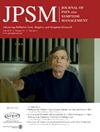以家庭为基础的姑息治疗的质量指标:一项系统综述。
IF 3.5
2区 医学
Q2 CLINICAL NEUROLOGY
引用次数: 0
摘要
背景:以家庭为基础的姑息治疗(HPC)的优势越来越得到认可,导致对这种护理模式的需求不断增长。HPC所需的质量指标(QIs)在范围和重点上可能与其他护理环境中使用的指标不同。目的:本综述旨在识别和整合HPC提供的质量指标。方法:检索PubMed、Medline、CINAHL、Cochrane Library、Web of Science和Embase数据库,确定所有关于QIs的HPC文章。从这些文章中提取的QIs按结构、过程或结果进行分类,映射到八个护理领域,并评估其方法学特征。结果:最终纳入15篇文章,包含312个独特的QIs。结果指标占45.5%,过程指标占39.1%。最常被提及的护理领域是“护理的结构和过程”(44.2%)和“护理的物理方面”(28.8%),而QIs最少的是“护理的精神、宗教和存在方面”(2.2%)和“护理的文化方面”(1.6%)。各研究的方法学质量评估差异很大,有7篇文章被评为高质量。结论:本研究整合了HPC的QIs。大多数已确定的质量指标是结果或过程指标。然而,较少涉及社会,文化和精神关怀领域。验证也是有限的,因为这些QIs中只有一小部分符合进一步测试的足够标准。未来的研究可以考虑扩大与文化敏感性、家庭远程医疗法规、主观经验和偏好相关的QIs,以促进更彻底和可靠的评估,以改善HPC服务的质量评估。本文章由计算机程序翻译,如有差异,请以英文原文为准。
Quality Indicators for Home-Based Palliative Care: A Systematic Review
Context
The advantages of home-based palliative care (HPC) are becoming increasingly acknowledged, resulting in a growing demand for this care model. The quality indicators (QIs) required for HPC may differ in scope and focus from those used in other care settings.
Objectives
This review aimed to identify and integrate QIs for the provision of HPC.
Methods
We searched PubMed, Medline, CINAHL, Cochrane Library, Web of Science and Embase databases to identify all articles on QIs for HPC. The QIs extracted from these articles were categorized by structure, process, or outcome, mapped to 8 care domains, and their methodological characteristics were evaluated.
Results
Fifteen articles were ultimately included, comprising 312 unique QIs. Among these, 45.5% were outcome indicators, 39.1% were process indicators. The most frequently addressed care domain were “Structure and Process of Care” (44.2%) and “Physical Aspects of Care” (28.8%), whereas the fewest QIs pertained to “Spiritual, Religious and Existential Aspects of Care” (2.2%) and “Cultural Aspects of Care” (1.6%). Methodological quality assessment varied considerably across the studies, with 7 articles rated as high quality.
Conclusions
This study integrated QIs for HPC. The majority of identified QIs were outcome or process indicators. However, fewer addressed social, cultural, and spiritual care domains. Validation was also limited, as only a small proportion of these QIs met sufficient criteria for warrant further testing. Future research could consider expanding QIs related to cultural sensitivity, home telehealth regulations, and subjective experiences and preferences to facilitate a more thorough and reliable assessment to improve the quality assessment of HPC services.
求助全文
通过发布文献求助,成功后即可免费获取论文全文。
去求助
来源期刊
CiteScore
8.90
自引率
6.40%
发文量
821
审稿时长
26 days
期刊介绍:
The Journal of Pain and Symptom Management is an internationally respected, peer-reviewed journal and serves an interdisciplinary audience of professionals by providing a forum for the publication of the latest clinical research and best practices related to the relief of illness burden among patients afflicted with serious or life-threatening illness.

 求助内容:
求助内容: 应助结果提醒方式:
应助结果提醒方式:


